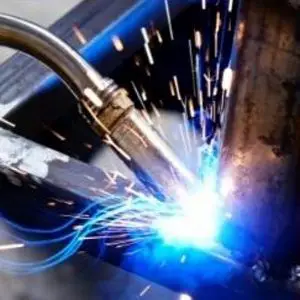Most people know that welding can be dangerous because it involves working with high-temperature flames and hot metals. However, few people are aware of the dangers of UV radiation exposure from welding.
What is Welding?
Welding is a fabrication process that joins metals or thermoplastics by using high heat to melt the workpieces and cause them to fuse. Welding is distinguished from other joining processes, such as brazing and soldering, which do not melt the base metal.
In welding, there are three main types of heat transfer: conduction, convection, and radiation. A conductor is defined as a material that readily transfers heat by conduction. Convection is the process of heat transfer by the movement of fluids. Radiation is heat transfer that occurs through electromagnetic waves.
What is UV Radiation?
Ultraviolet radiation (UV) is a form of electromagnetic radiation that is invisible to the human eye but can be harmful to humans and other living things. UV radiation is present in sunlight and is emitted by certain artificial light sources, such as tanning beds and black lights. It can also be produced by welding arcs and plasma torches.
Does Welding Give Off UV Radiation?
Yes, Welding does give off UV radiation, but the amount varies depending on the type of welding process and the materials being used. The risk of UV exposure can be minimized by using proper safety equipment, such as welding goggles or a face shield.
Welding arcs emit a large amount of UV radiation, most of which is in the UVC range. Plasma torches emit a large amount of UV radiation in all three ranges (UVA, UVB, and UVC). Black lights emit mostly UVA Radiation. Tanning beds emit both UVA and some UVB Radiation.
Welders are at high risk for UV radiation exposure because they often work in close proximity to the UV light source. In addition, many welders do not wear proper eye protection, further increasing their exposure risk.
Welding helmets are designed to protect your eyes and face from the UV radiation emitted by welding arcs. They should be worn whenever you are welding, even if you are just watching someone else weld. Be sure to choose a helmet that is rated for the specific type of welding you will be doing.
In addition to wearing a welding helmet, you should also wear proper eye and face protection when working around welders. This includes safety glasses or goggles, and a face shield. Wearing the proper clothing is also important. Long sleeves and long pants made of heavy-duty fabrics can help protect your skin from UV radiation exposure.
Dangers of UV Radiation
Exposure to UV radiation can cause sunburn, skin cancer, eye damage, and other health problems. UV radiation is classified into three categories: UVA, UVB, and UVC. UVA radiation makes up the majority of UV radiation that reaches the Earth’s surface; it is less energetic than UVB and UVC Radiation, but it can penetrate the atmosphere more deeply. UVB radiation is more energetic than UVA but does not penetrate the atmosphere as deeply. UVC radiation is the most energetic form of UV Radiation but is completely absorbed by the Earth’s atmosphere and does not reach the ground.
Protecting Yourself from UV Radiation
There are several ways to protect yourself from UV radiation exposure when welding. First, wear proper eye protection, such as a welding helmet or glasses with shading no lighter than shade. Second, try to stay at least 2 feet away from the arc whenever possible. Third, use a welding curtain or screen to block UV rays when working in close proximity to the arc.
By following these simple safety tips, you can help protect yourself from the dangers of UV radiation exposure while welding.
Conclusion
Welding is one of the most common sources of UV radiation exposure to industrial workers. The UV radiation emitted by welding arcs can cause both immediate and long-term damage to your eyes. It can also damage your skin if you are not properly protected. So, if you are going to weld, make sure to wear adequate eye and skin protection.


